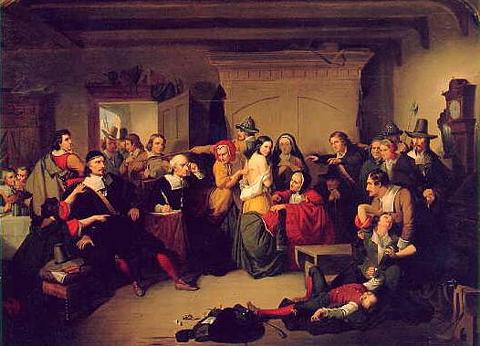|
NY Regents Exam
Salem Witch Trials
Easier - In the summer of 1692, ignorance and fear ruled over Puritan Salem, Massachusetts. Several men and women stood
trial for witchcraft. People called them witches and believed the devil had given them special powers. Nineteen of the accused
were judged guilty and put to death by hanging. Another was crushed to death for not pleading guilty. Many others suffered
and some died as a result of the turmoil and mistreatment.
Harder - It was a tough, cold winter in Salem, Massachusetts and sometime during February 1692, a small girl became
strangely ill. She complained of pain and fever, burst out in incomprehensible gibberish, experienced convulsions and contortions;
her symptoms baffled everyone. Cotton Mather had just written a popular book describing suspected witchcraft in nearby Boston.
Then three other girls, playmates of the afflicted Betty Parris, began to exhibit similar unusual behaviors. Doctor Griggs
examined the girls and after his first administrations failed, he declared that the girls' afflictions might be the result
of witchcraft.
That grim diagnosis triggered a Puritan inquisition throughout the community. Finger pointing began. The first to
be arrested were a Caribbean-born slave along with Sarah Good and Sarah Osburn, two elderly women of poor reputation. The
hysteria raged into the summer months and filled the prisons with innocent people. Eventually, 150 "witches" were
taken into custody. By late September, 19 men and women had been hanged on Gallows Hill, an eighty year old man pressed to
death under stones for refusing a trial, five more accused had died in jail, but none of the executed had confessed to witchcraft.
Then almost as fast as it had started, the witch hunt ended.

Easier - In the summer of 1692, ignorance and fear ruled over Puritan Salem, Massachusetts. Several men and women stood
trial for witchcraft. People called them witches and believed the devil had given them special powers. Nineteen of the accused
were judged guilty and put to death by hanging. Another was crushed to death for not pleading guilty. Many others suffered
and some died as a result of the turmoil and mistreatment.
Harder - It was a tough, cold winter in Salem, Massachusetts and sometime during February 1692, a small girl became
strangely ill. She complained of pain and fever, burst out in incomprehensible gibberish, experienced convulsions and contortions;
her symptoms baffled everyone. Cotton Mather had just written a popular book describing suspected witchcraft in nearby Boston.
Then three other girls, playmates of the afflicted Betty Parris, began to exhibit similar unusual behaviors. Doctor Griggs
examined the girls and after his first administrations failed, he declared that the girls' afflictions might be the result
of witchcraft.
That grim diagnosis triggered a Puritan inquisition throughout the community. Finger pointing began. The first to
be arrested were a Caribbean-born slave along with Sarah Good and Sarah Osburn, two elderly women of poor reputation. The
hysteria raged into the summer months and filled the prisons with innocent people. Eventually, 150 "witches" were
taken into custody. By late September, 19 men and women had been hanged on Gallows Hill, an eighty year old man pressed to
death under stones for refusing a trial, five more accused had died in jail, but none of the executed had confessed to witchcraft.
Then almost as fast as it had started, the witch hunt ended.
|

